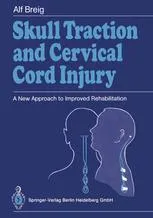Skull Traction and Cervical Cord Injury: A New Approach to Improved Rehabilitation
4.3
Reviews from our users

You Can Ask your questions from this book's AI after Login
Each download or ask from book AI costs 2 points. To earn more free points, please visit the Points Guide Page and complete some valuable actions.Related Refrences:
Introduction to "Skull Traction and Cervical Cord Injury: A New Approach to Improved Rehabilitation"
Welcome to a comprehensive exploration of groundbreaking strategies in the rehabilitation of cervical cord injuries. This book presents a clinically innovative approach focused on the use of skull traction, offering a revitalized perspective on treatment protocols aimed at enhancing patient recovery and quality of life.
Detailed Summary of the Book
The aim of this book is to shed light on the novel methodologies employed in the rehabilitation of cervical cord injuries, particularly through the use of skull traction apparatus. It delves into the intricacies of spinal cord dynamics, the biomechanical insights into cord-stretch injuries, and the role which skull traction plays in alleviating these conditions.
Over the course of multiple chapters, the book examines the pathophysiology of cervical injuries with an emphasis on the mechanical and biological aspects that contribute to injury prevention and recovery. Readers are introduced to new findings related to the biomechanics of the cervical spine, followed by discussions on traditional versus modern traction techniques. One of the pivotal elements addressed is the customization of rehabilitation strategies to fit the individualized needs of patients, based on detailed diagnostic evaluations.
Additionally, the work provides a thorough analysis of clinical case studies that demonstrate the efficacy of skull traction interventions. By blending theoretical knowledge with clinical experience, it endeavors to establish a more empirical approach towards achieving optimal outcomes in patient rehabilitation.
Key Takeaways
- Understanding the biomechanics of cervical cord injuries is crucial for effective rehabilitation.
- Skull traction can play a pivotal role in the therapeutic management of cervical injuries, enhancing the existing treatment paradigms.
- Each patient presents a unique challenge, necessitating personalized rehabilitation strategies.
- Integration of biomechanical insights with clinical practices can significantly improve patient outcomes.
Famous Quotes from the Book
"The quest for understanding spinal mechanics is not merely academic; it directly translates to saving lives and restoring functionality."
"In the realm of spinal rehabilitation, where every millimeter counts, precision is paramount and innovation is imperative."
Why This Book Matters
With the growing prevalence of cervical cord injuries, there is a pressing need for refining and reimagining rehabilitative practices. This book stands as a beacon of advancement in medical treatment, providing both seasoned clinicians and medical students with fresh insights into the management of spinal injuries.
By focusing on skull traction, the text challenges conventional beliefs and prompts the adoption of progressive techniques that have shown to accelerate healing processes and improve functional recovery. It also serves as a valuable resource for ongoing research and development in the field of spinal injury rehabilitation, fostering a deeper understanding of both the clinical and biomechanical realms.
Ultimately, this book contributes to the overarching goal of enhancing patient care and maximizing rehabilitation success, making it an indispensable addition to the annals of spinal injury literature.
Free Direct Download
You Can Download this book after Login
Accessing books through legal platforms and public libraries not only supports the rights of authors and publishers but also contributes to the sustainability of reading culture. Before downloading, please take a moment to consider these options.
Find this book on other platforms:
WorldCat helps you find books in libraries worldwide.
See ratings, reviews, and discussions on Goodreads.
Find and buy rare or used books on AbeBooks.
1324
بازدید4.3
امتیاز50
نظر98%
رضایتReviews:
4.3
Based on 0 users review
"کیفیت چاپ عالی بود، خیلی راضیام"
Questions & Answers
Ask questions about this book or help others by answering
No questions yet. Be the first to ask!




